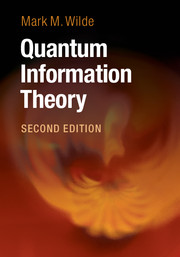Book contents
- Frontmatter
- Contents
- Preface to the Second Edition
- Preface to the First Edition
- How To Use This Book
- Part I Introduction
- Part II The Quantum Theory
- Part III Unit Quantum Protocols
- Part IV Tools of Quantum Shannon Theory
- Part V Noiseless Quantum Shannon Theory
- Part VI Noisy Quantum Shannon Theory
- Introduction
- 20 Classical Communication
- 21 Entanglement-Assisted Classical Communication
- 22 Coherent Communication with Noisy Resources
- 23 Private Classical Communication
- 24 Quantum Communication
- 25 Trading Resources for Communication
- 26 Summary and Outlook
- Appendix A Supplementary Results
- Appendix B Unique Linear Extension of a Quantum Physical Evolution
- References
- Index
23 - Private Classical Communication
from Part VI - Noisy Quantum Shannon Theory
Published online by Cambridge University Press: 16 February 2017
- Frontmatter
- Contents
- Preface to the Second Edition
- Preface to the First Edition
- How To Use This Book
- Part I Introduction
- Part II The Quantum Theory
- Part III Unit Quantum Protocols
- Part IV Tools of Quantum Shannon Theory
- Part V Noiseless Quantum Shannon Theory
- Part VI Noisy Quantum Shannon Theory
- Introduction
- 20 Classical Communication
- 21 Entanglement-Assisted Classical Communication
- 22 Coherent Communication with Noisy Resources
- 23 Private Classical Communication
- 24 Quantum Communication
- 25 Trading Resources for Communication
- 26 Summary and Outlook
- Appendix A Supplementary Results
- Appendix B Unique Linear Extension of a Quantum Physical Evolution
- References
- Index
Summary
We have now seen in Chapters 20–22 how Alice can communicate classical or quantum information to Bob, perhaps even with the help of shared entanglement. One might argue that these communication tasks are the most fundamental tasks in quantum Shannon theory, given that they have furthered our understanding of the nature of information transmission over quantum channels. However, when discussing the communication of classical information, we made no stipulation as to whether this classical information should be public, so that any third party might have partial or full access to it, or private, so that no third party has access.
This chapter establishes the private classical capacity theorem, which gives the maximum rate at which Alice can communicate classical information privately to Bob without anyone else in the universe knowing what she sent to him. A variation of the information-processing task corresponding to this theorem was one of the earliest studied in quantum information theory, with the Bennett– Brassard-84 quantum key distribution protocol being the first proposed protocol for exploiting quantum mechanics to establish a shared secret key between two parties. The private classical capacity theorem is important for quantum key distribution because it establishes the maximum rate at which two parties can generate a shared secret key.
Another equally important, but less obvious utility of private classical communication is in establishing a protocol for quantum communication at the coherent information rate. Section 22.2 demonstrated a somewhat roundabout way of arriving at the conclusion that it is possible to communicate quantum information reliably at the coherent information rate—recall that we “coherified” the entanglement-assisted classical capacity theorem and then exploited the coherent communication identity and catalytic use of entanglement. Establishing achievability of the coherent information rate via private classical coding is another way of arriving at the same result, with the added benefit that the resulting protocol does not require the catalytic use of entanglement.
The intuition for quantum communication via privacy arises from the nocloning theorem. Suppose that Alice is able to communicate private classical messages to Bob, so that the channel's environment (Eve) is not able to distinguish which message Alice is transmitting to Bob.
- Type
- Chapter
- Information
- Quantum Information Theory , pp. 624 - 641Publisher: Cambridge University PressPrint publication year: 2017
- 1
- Cited by



